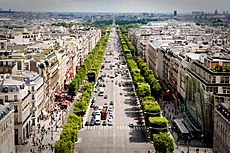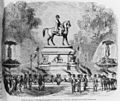Champs-Élysées facts for kids
The Avenue des Champs-Élysées is a famous street in Paris, France. It is about 1.9 kilometers (1.2 miles) long and 70 meters (230 feet) wide. This grand avenue connects two important places: the Place de la Concorde and the Place Charles de Gaulle. The famous Arc de Triomphe stands at the Place Charles de Gaulle.
The Champs-Élysées is known for its many theatres, cafés, and fancy shops. It is also where the big Bastille Day military parade happens every year. Plus, it's the finish line for the exciting Tour de France cycling race!
The name "Champs-Élysées" means "Elysian Fields" in French. In Greek mythology, the Elysian Fields were a beautiful place where heroes went after they died. Many people think the Champs-Élysées is one of the most recognizable avenues in the world.
Contents
What is the Champs-Élysées like?
This famous avenue stretches for about 1.9 kilometers (1.2 miles) through the 8th area of Paris. It starts in the east at the Place de la Concorde, where you can see the Obelisk of Luxor. It ends in the west at the Place Charles de Gaulle. This square used to be called the Place de l'Étoile. Here, you'll find the impressive Arc de Triomphe. The Champs-Élysées is part of a straight line of monuments called the Axe historique.
The lower part of the Champs-Élysées, from the Place de la Concorde, goes through a park. This park is called the Jardin des Champs-Élysées. In this park, you can find the Grand Palais and the Petit Palais. There's also the Théâtre Marigny and many restaurants and gardens. The Élysée Palace is next to the park. This palace is where the President of France lives and works. The Champs-Élysées finishes at the Arc de Triomphe. This monument was built to celebrate the victories of Napoleon Bonaparte.
How did the Champs-Élysées begin?
Long ago, the area where the Champs-Élysées is now was just fields and gardens. In 1616, a queen named Marie de' Medici decided to make a long path of trees. This path was an extension of the Tuileries Garden. Even in 1716, maps showed that there were still fields separating the garden from this new tree-lined path.
By the late 1700s, the Champs-Élysées became a very popular and fashionable street. The trees on both sides had grown thick. Important people like Queen Marie Antoinette would visit the grand Hôtel de Crillon nearby. The street became city property in 1828. After that, sidewalks, fountains, and gas lights were added. The avenue has changed many times over the years. In 1994, for example, the sidewalks were made wider.
Because of its size and location, the Champs-Élysées has seen many important events. It has been the site of several military parades. For example, German troops marched there in 1940. Later, after Paris was freed in 1944, French and American soldiers marched there to celebrate. The French 2nd Armored Division marched on August 26, 1944. The US 28th Infantry Division marched on August 29, 1944.
What events happen on the Champs-Élysées?

Every year on Bastille Day, July 14, a huge military parade takes place. This is one of the biggest military parades in Europe. The President of France watches the parade as it goes down the Champs-Élysées.
Around Christmas time, from late November to early January, the Champs-Élysées lights up! Special committees help decorate the avenue with beautiful holiday lights.
Since 1975, the very last part of the Tour de France cycling race finishes on the Champs-Élysées. The winners get their awards right on the avenue.
Huge crowds often gather on the Champs-Élysées for big celebrations. This happens on New Year's Eve. It also happened when the French national football team won the FIFA World Cup in 1998 and 2018. Sometimes, large political protests also happen here.
How to get there by public transport?
The Paris Métro Line 1 runs right under the Champs-Élysées. You can find the Charles de Gaulle – Étoile station at the west end of the street. There are also three other stations with entrances on the avenue itself. From west to east, these are:
- George V (near the Hôtel George-V)
- Franklin D. Roosevelt (at the middle roundabout)
- Champs-Élysées – Clemenceau (at Place Clemenceau)
- Concorde (at the south end, near the Place de la Concorde)
Images for kids
-
The historical axis, looking west from Place de la Concorde (the Obelisk of Luxor is in the foreground).
-
The Champs-Elysées seen from the Arc de Triomphe.
-
Footpath near the Arc de Triomphe.
-
Statue of Napoleon Bonaparte erected at Champs-Élysées in 1852, soon after the coronation of Napoleon III.
-
The Free French 2nd Armored Division marches down the Champs-Élysées on 26 August 1944 to celebrate the Liberation of Paris.
-
American troops of the 28th Infantry Division march down the Avenue des Champs-Élysées, Paris, in the Victory Parade on 29 August 1944.
-
The Champs-Élysées seen from the Arc de Triomphe
-
President Emmanuel Macron and General François Lecointre, Chief of the Defence Staff, reviewing troops at the 2019 Bastille Day military parade.
See also
 In Spanish: Avenida de los Campos Elíseos para niños
In Spanish: Avenida de los Campos Elíseos para niños


















